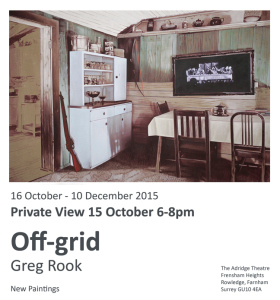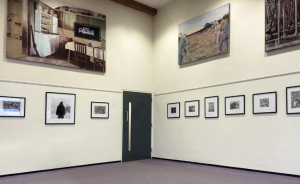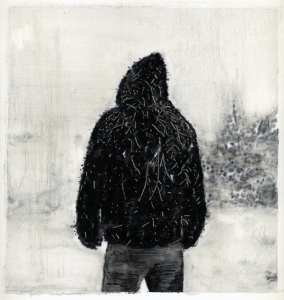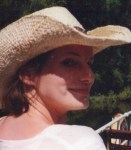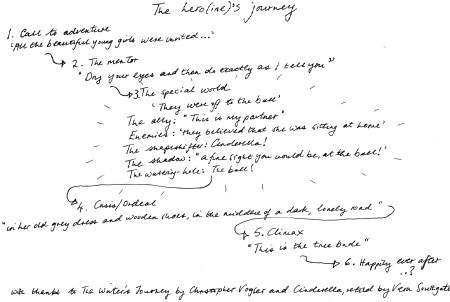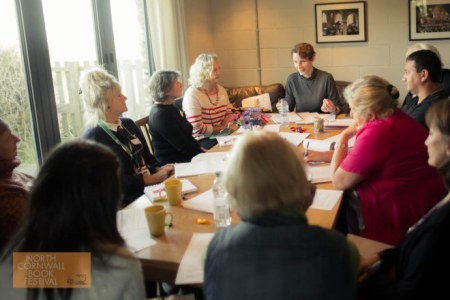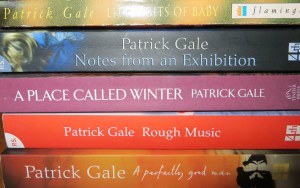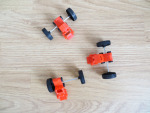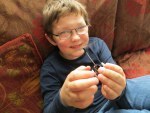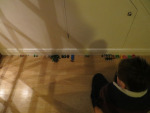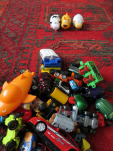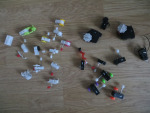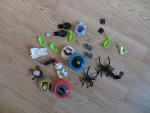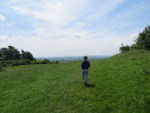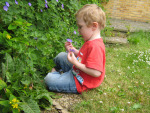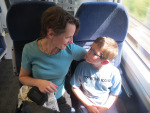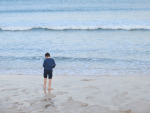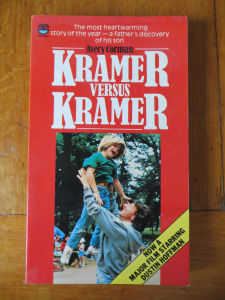Alison Mercer's Blog, page 2
December 29, 2015
What I read in 2015: Ferrante, Patrick Gale and plenty more…

with Patrick Gale at North Cornwall Book Festival. Photo: Dan Hall
2015 was my year of reading Patrick Gale. I read a few more of his novels as prep for interviewing him at North Cornwall Book Festival (lucky me): Little Bits of Baby, Rough Music and A Perfectly Good Man. I also looked back over his 2015 bestseller A Place Called Winter and was knocked out by it a second time, having first read a proof copy last year (yup – lucky me again).

This was also the year I caught Ferrante fever – I read the first of the Neapolitan novels and know I’m in for a treat with the rest. It’s rare to read a writer who captures so precisely what it is like to be a woman. Like Ferrante’s legions of other fans, I was drawn in and hooked fast by her brilliant depiction of the novel’s central female friendship, in all its ambiguous tenderness and competitiveness.
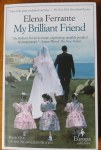
It’s been a year for going along to literary events and coming back with books. I stocked up at North Cornwall Book Festival, which has dominated my reading in recent months – the tent may be down, the sand long since shaken out of our suitcases, but NCBF lives on… It was great to see Jenny Balfour Paul, Patricia Duncker and M J Carter speaking about their books, and an even more lasting pleasure to read them (Deeper than Indigo, Sophie and the Sibyl and The Strangler Vine, which I’m reading at the moment. All brilliant.)
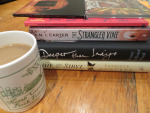
Another star of the festival was Neel Mukherjee, whose novel The Lives of Others I read last year, when it was shortlisted for the Man Booker Prize. (Here’s what I read in 2014.)

On a blazing autumn day in October I went to see Patrick Gale and Polly Samson in conversation at Henley Literary Festival – a startlingly steamy event (for an afternoon in a sedate town hall.) Polly’s new book, The Kindness, is a cleverly constructed tale of love, deception and thwarted paternity, due out in paperback in March.
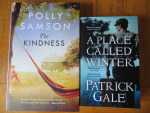
Back in June, I spent a gloriously sunny evening in the courtyard garden of Mostly Books in Abingdon, listening to Laura Barnett talk about her twisty-turny, three-layered what-if narrative The Versions of Us. I also went along to see honorary Abingdon author Rebecca Wait (The Followers – a vivid and terrifying account of life as a teen inside a cult) at a panel event at Blackwell’s Oxford discussing whether novels can teach empathy.
In April, I went to Chipping Norton Literary Festival, where I missed out on Lee Child’s event but spotted him looking conspicuously tall and charismatic outside Jaffe and Neale. I saw Matt Haig (Reasons to Stay Alive – advice and insights on recovering from depression) in conversation with Cathy Rentzenbrink (The Last Act of Love – a memoir about her brother, who was left in a permanent vegetative state after a car accident, and the impact this had on the family: an unsparingly honest book that is as warm and tender as it is painful). I also saw Hannah Beckerman, Clare Mackintosh and Rowan Coleman speaking about mothers in fiction – and Richard and Judy!
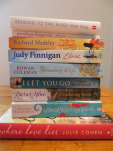
This was the year I discovered Molesworth, which I have been dipping into from time to time over the festive season. Whether you’re looking for eternal verities or merely hunting for something to cheer you up before you go back to work, you may find what you seek in the comprehensively misspelled collected works of this 1950s schoolboy… Turn to Gerald Scarfe’s illustrations of types of teacher and parent, or the sketch of a manager, and you’ll see what I mean.
Also, if you’re in need of amusement and haven’t yet discovered Nina Stibbe, it’s time to get your hands on Love, Nina and Man at the Helm. (You will never see turkey mince in the same way again.) I am very much looking forward to seeing Love, Nina on the telly (Nick Hornby has adapted it – Helena Bonham-Carter is in it). I’ll also be looking out for Patrick Gale’s two-part TV drama, Man in an Orange Shirt in 2016. (And when is Poldark back on? Really really soon I hope. January is loooooong.)
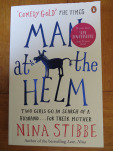
I’ve read proof copies of two novels that are due out in 2016 (lucky me again): Sarah Duguid’s debut Look At Me, a sharp and suspenseful tale of sibling rivalry, and Monica Wood’s big-hearted One in a Million Boy. This is about an elderly woman trying to survive her way into the record books, a jobbing musician trying to compensate for his failings as a father, and the charming and unusual boy of the title, whose sudden disappearance draws together those he has left behind. Two to look out for!
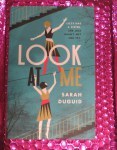
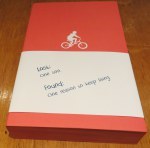
So what will I be reading in 2016? Steve Silberman’s NeuroTribes is waiting, along with Patrick Gale’s A Sweet Obscurity and Friendly Fire, and I’d like to read more Penelope Fitzgerald – this year I read Offshore and as I’m working my way through in chronological order it’ll be Human Voices next.
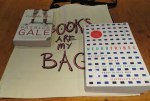
Also, I’ve lined up the autobiographies of Bob Evans and Roger Vadim (research – I’ve read both before), along with Eve Chase’s Black Rabbit Hall and the first of Elizabeth Jane Howard’s Cazalet Chronicles. I expect (and hope) I’ll discover many more new books and new authors. There are always surprises in the book store…

A big thank you to all the readers of this blog – here’s to happy reading and good times in 2016!
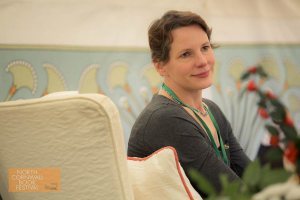
At North Cornwall Book Festival. Photo: Dan Hall
What I read in 2015… the list
So here’s that rather long list of what I read in 2015, in approximately reverse order.
One in a Million Boy by Monica Wood
Deeper than Indigo by Jenny Balfour Paul
Sophie and the Sibyl by Patricia Duncker
Look at Me by Sarah Duguid
Rough Music, A Perfectly Good Man, Little Bits of Baby by Patrick Gale
The Kindness by Polly Samson
The Last Act of Love by Cathy Rentzenbrink (‘I know I’m damaged. As I’ve walked through fire, bits of me have burnt off – but I accept that.’)
Diana by R F Delderfield (not for the first time!)
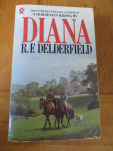
My Brilliant Friend by Elena Ferrante
Man at the Helm by Nina Stibbe
The Versions of Us by Laura Barnett
The Followers by Rebecca Wait
How to be Both by Ali Smith
The Girl on the Train by Paula Hawkins (along with er 478,884 others, or thereabouts)
H is for Hawk by Helen Macdonald
Runaway Wife by Rowan Coleman
Reasons to Stay Alive by Matt Haig
Eloise by Judy Finnigan
Chocolate Wishes by Trisha Ashley
The Story of You by Katy Regan
Offshore by Penelope Fitzgerald
A Gathering Storm by Rachel Hore
The Butterfly Box by Santa Montefiore
Me Before You by Jojo Moyes
Her by Harriet Lane (a wonderfully effective and chilling conjuring up of pure malice)
The Miniaturist by Jessie Burton
Elizabeth is Missing by Emma Healey (warmly discussed at my work book club – my daughter was also a fan)
The Love of My Life by Louise Douglas

Love, Nina by Nina Stibbe
Daughter by Jane Shemilt
Apple Tree Yard by Louise Doughty
The Rosie Project by Graeme Simsion
Travelling to Infinity by Jane Hawking

Kramer vs Kramer by Avery Corman
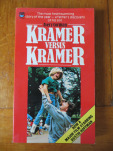
And also in 2015…
I taught my first creative writing workshop (at North Cornwall Book Festival).
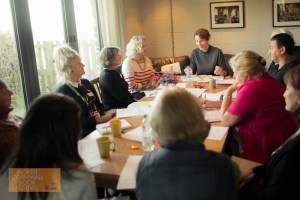
Photo: Dan Hall
I wrote… More to follow in 2016…




November 5, 2015
Off-grid: Greg Rook’s paintings of a post-apocalyptic Good Life
What would life look like stripped of technology, in a possible post-disaster future? That’s the question posed by Greg Rook in his atmospheric and rather ominous Off-grid paintings and drawings, which you can see at the Aldridge theatre in Farnham till 10 December. Apparently prepping stores (where you can get everything you need to survive an apocalypse) are commonplace in the US and are on their way over here. Is this the kind of future their client base is imagining?
Eagle-eyed readers of this blog will remember that I once went to an earlier exhibition of Greg’s work on this theme – his Survivors paintings. I asked him what he thought he might end up doing if he lived in the kind of commune he had portrayed. He said he thought he’d probably be a terrible survivor, and went on to predict that men in particular would fall prey to strange new post-apocalyptic schools of thought: ‘I worry about men’s tendency to get lost in beliefs and self-importance and I predict that women would carry the burden of providing following a collapse. I imagine factions, sects, conspiracies and theories occupying the men’s time.’
So would the people pictured in these paintings survive? ‘Ultimately we are adaptable and our happiness is relative to our circumstances. If our expectations become limited then our aspirations shrink to fit, and what we require to survive adapts accordingly.’
Here’s my Q&A about Greg’s work, covering influences, process (what does he listen to?) and research – and what it is that ‘makes his hands itch with wanting to paint’.
You can find out more from Greg’s website.
Regular readers of this blog will know that at the end of October I went to North Cornwall Book Festival and was put up with a number of authors in a farmhouse at St Endellion. If apocalypse had struck and left us stranded there, who knows, we might have all had to turn our hands to agrarian living…
At least we’d have had Patrick Gale to teach us about farming. And perhaps Neel Mukherjee’s experience of scything would have had a practical application in addition to its literary effectiveness (it was undertaken as research for the brilliant scene where Supratik, the revolutionary in The Lives of Others, struggles to learn the technique and keep going in the brutal heat. As Neel explained in conversation with Patricia Duncker at NCBF, he found it extraordinarily difficult and exhausting too…)


November 3, 2015
My time at North Cornwall Book Festival: a feast of books, music, conversation… and cake
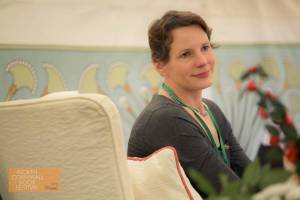
Photo: Dan Hall
I usually go to litfests to sit in the audience, not on the stage, so my recent trip to North Cornwall Book Festival was a little nerve-racking – though as it turned out there was nothing to fear, and everything to enjoy. I was involved in two events: first off I talked about my books to bestselling novelist and tirelessly hospitable festival host Patrick Gale, and then I hosted his talk about his latest book, A Place Called Winter. I also taught my first ever creative writing workshop.
I’m left with a blur of impressions: a marqueeful of primary school children laughing themselves silly at Christopher William Hill; sitting round the table at the farmhouse where most of us authors were staying, eating the most delicious poached pears; the moon rising over St Endellion Church, where we gathered for evening music of surprising and non-ecclesiastical kinds; lounging round in sudden sunlight on Sunday lunchtime when my workshop was done (you can see a photo of me with Patrick Gale and Neel Mukherjee at this point in this blog post about NCBF by BD Hawkey.)
There was a super-speedy blogging team from Falmouth Uni headquartered in the farmhouse – they wrote lots of great posts about the various author events and I’ve linked to several of them below – their NCBF blog is a really good whistle-stop tour of the whole experience. There are also loads more brilliant pics (thank you Dan Hall) on the NCBF FB page.
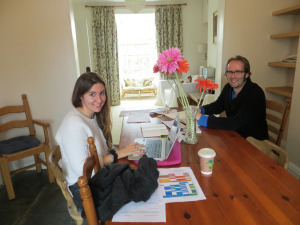
bloggers @charlottemsabin and @beakheads
North Cornwall Book Festival: authors and music galore
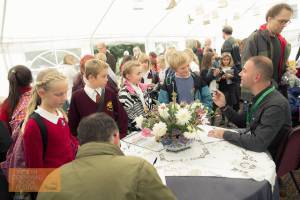
Moray Laing signing autographs
Photo: Dan Hall
These are the events I went to:
Dr Who expert Moray Laing on a roll-call of monsters old and new – the Weeping Angels are my scariest (just don’t blink…)
Patricia Duncker in conversation with Neel Mukherjee, Booker-shortlisted author of The Lives of Others – serious intellectual firepower.
Jenny Balfour-Paul on the journey of discovery that lead her ever deeper into the life of Victorian adventurer Thomas Machell, and their shared quest for indigo.
M J Carter – historian turned novelist – in conversation with Neel Mukherjee about her subversive Victorian detective fiction, set at a time of disorientating change with parallels to today.
Julia Copus reading spare, heartbreaking poems from The World’s Two Smallest Humans.
John Lanchester, author of Capital, in conversation with Philip Marsden. At the end, I was left thinking that banking is bonkers and we’re all probably stuffed. I still don’t really know what fiscal means, but I have faith that if I read John’s book How to Speak Money, I will.
At my event, I learned that Patrick Gale and I are both childhood fans of Mary Stewart, and talked about genre (one of the themes of the weekend) – here’s a bit more about it. As for Patrick, well, he must be the world’s easiest interviewee.

Patrick Gale
Photo: Dan Hall
The music at St Endellion Church was a revelation. I had to work seriously hard not to blub when Tom Hickox sang The First Time Ever I Saw Your Face (a song with associations and let’s face it, it’s a weep-inducer.)
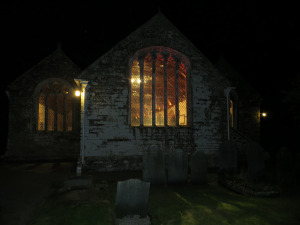
St Endellion Church
Wild Willy Barrett’s French Connection was irresistibly foot-tapping and got me in the mood for a hoedown. Missed my old cowgirl hat…
My workshop: handling romance in fiction
At my workshop we talked about the archetype of the hero’s journey, with Cinderella as an example.
We also looked at three key scenes from stories about love, and discussed how love stories are always also about something else: whatever it is that is coming between the lovers and creating dramatic tension in the story (and is the reason for the story to exist). These are the novels we looked at:
Me Before You by Jojo Moyes
Jane Eyre by Charlotte Bronte
A Place Called Winter by Patrick Gale

Photo: Dan Hall
These are the books I recommended on storytelling, writing and becoming a writer:
The Writer’s Journey – Christopher Vogler
Negotiating with the Dead – Margaret Atwood
On Writing – Stephen King
On Becoming a Novelist, The Art of Fiction – John Gardner
The Writer’s Voice – Al Alvarez
Wild Mary – Patrick Marnham
And here are some of the characters and places we came up with for our meet cute exercise, just in case someone wants to give it a go (five minutes, take two characters and a place and write their meeting). It’s amazing what it’s possible to come up with in such a short space of time and reading what you’ve written out loud is always useful (turns out Patrick Gale does this a lot when he’s working on a new book).
Characters
Lottery winner
Someone who missed last train
Ex-boyfriend
Single parent on benefits
Soldier with PTSD
Coffee barista
Dog
Santa (someone dressed as)
Ex-vicar
Bailiff
Make-up artist
Policewoman
Depressed Hollywood star
Antiques dealer
American yoga teacher
Bank robber
Weather forecaster
Places
Fancy dress party
Camping site in the rain
Traffic jam
The moor at dawn
Edge of a cliff
Therapist’s waiting room
Manhattan rooftop
Village pub
Launderette
Smoking shelter
Ferry to a Greek island
Billiard table (full-size)
Purgatory
All good things must come to an end (till next time), and come Monday morning I was spirited away from the magic of NCBF to the much more familiar (but suddenly novel) magic of home. It was lovely to get back and have a big group hug – it was the longest I’d ever been away from my children. But the festival has stayed with me and so it will remain through the winter as this treasure trove sees me through the dark, the fog and the gloom:
If you’re in Cornwall next October half-term – do go! It will set you up for the winter. Oh, and did I mention the pasties and the cakes? No? A terrible omission. NCBF is a feast of all kinds, as you’ll see when you get there.

the flowers in each author’s room
Litfest events I have loved
Polly Samson and Patrick Gale: seduction, loss, land and longing
Steve Shirley, the Kindertransport and the most loving thing a parent can do
Matt Haig’s Reasons to Stay Alive, Richard and Judy and mothers in fiction


November 1, 2015
North Cornwall Book Festival, Pasties & Cake.
it was lovely to read this write-up about North Cornwall Book Festival!
 Originally posted on b.d.hawkey:
Originally posted on b.d.hawkey:
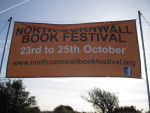 I believe to be a great writer one has to read a lot and be willing to learn from others. Book festivals are a great way to meet fellow readers and writers. The North Cornwall Book Festival, which this year was held entirely in the small parish of St.Endellion, was no exception. Although it ran for three days at the end of October, I was only able to attend the final day. However, I couldn’t have picked a better day, the autumn sun was shining, the people (both authors and visitors) were friendly, and the pasties and cake for sale were delicious.
I believe to be a great writer one has to read a lot and be willing to learn from others. Book festivals are a great way to meet fellow readers and writers. The North Cornwall Book Festival, which this year was held entirely in the small parish of St.Endellion, was no exception. Although it ran for three days at the end of October, I was only able to attend the final day. However, I couldn’t have picked a better day, the autumn sun was shining, the people (both authors and visitors) were friendly, and the pasties and cake for sale were delicious.
For those who have never been to a book festival before, it is open to all who have an interest in reading 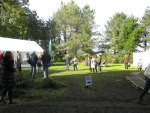 and/or writing. It usually involves a variety of presentations, workshops, interviews, readings and book signings by authors, with the aim of fostering a love of literature…
and/or writing. It usually involves a variety of presentations, workshops, interviews, readings and book signings by authors, with the aim of fostering a love of literature…
View original 735 more words


October 28, 2015
Alison Mercer on writing Romantic Fiction
It’s true – I love Cornwall even in the rain. And I am still a fan of Mary Stewart!
 Originally posted on North Cornwall Book Festival 2015:
Originally posted on North Cornwall Book Festival 2015:
by Charlotte Sabin
“What do we mean by Romance? Do we mean love stories? Because love stories exist in all kinds of genres.”
Alison Mercer
Alison Mercer is a fan of Cornwall (as she explained this to me, rain hammered against the windows of our farmhouse green room – so she’s being serious). We are very glad to have her here all weekend, delighting audiences with a talk as well as a workshop on writing romantic fiction.
This trip down for the North Cornwall Book Festival is all research material for her next novel, set partially in Cornwall. “The Saturday Mother” follows a mother’s relationship with her daughter under the strain of divorce, and a custody battle won by her ex-husband. Writing in the daughter’s voice was a fantastic experience, Alison explains – but she’s not tempted by writing YA just yet, love stories got her enticed into books in the…
View original 175 more words


October 27, 2015
Handling Romance with Alison Mercer
I really enjoyed leading this workshop at North Cornwall Book Festival – good times all round!
 Originally posted on North Cornwall Book Festival 2015:
Originally posted on North Cornwall Book Festival 2015:
by Elisabeth Strasser @LPenkiller
This morning everybody interested in improving romance in their stories gathered in the cosy atmosphere of the Stone Barn with tea, cake and sweets at the North Cornwall Book Festival. Alison Mercer is well prepared with an outline of her workshop. I recognise The Hero’s Journey on her handout, which is a great tool for structure in storytelling derived from ancient myths.
In the introduction round it becomes clear that there is a good mix of participants with various backgrounds. Self-published authors sit next to traditionally published authors. Some are working on their first novel while others have sent in manuscripts and been rejected. Alison Mercer, the author of Stop the Clock and After I left You encourages everyone, saying “it happens to everybody.” It is important for every writer to have the ability to get through rejection and “soldier on”, comforting words to hear from…
View original 172 more words


October 2, 2015
Polly Samson and Patrick Gale: seduction, loss, land and longing
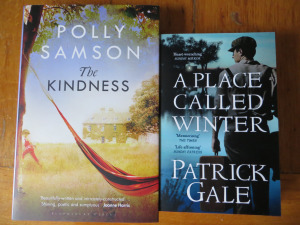 Outside was a preposterously beautiful, Technicolour autumn day, all blue skies and trees turning the colours of fire. If you’d used it in a film it would have been for heartbreak and parting, a belated outpouring of summer made all the more vivid because it is nearly time to say goodbye. Inside the grand but compact chamber of Henley’s Town Hall it was unseasonably warm; with five minutes to go there were only two seats left, and I took one of them. ‘Not much knee space. We’re rather close,’ somebody said as I squeezed in and arranged myself.
Outside was a preposterously beautiful, Technicolour autumn day, all blue skies and trees turning the colours of fire. If you’d used it in a film it would have been for heartbreak and parting, a belated outpouring of summer made all the more vivid because it is nearly time to say goodbye. Inside the grand but compact chamber of Henley’s Town Hall it was unseasonably warm; with five minutes to go there were only two seats left, and I took one of them. ‘Not much knee space. We’re rather close,’ somebody said as I squeezed in and arranged myself.
We were a packed and anticipant roomful of mostly women, book lovers and therefore by definition fond of the essentially private pastime of reading, though we were there not to read but to listen and to ask questions, to experience fiction as a public event. Instead of words on a page or a screen, we were going to see the writers who had drawn us there and hear their voices. We wanted stories, but more than that, we hoped for a glimpse into how and why they were told.
At one end of the room was a small and empty stage with three important-looking chairs, which were throne-like but in the manner of an English town hall and therefore designed for the comfortable sitting-out of long meetings as well as to be imposing. I imagine all sorts of practical things have been discussed in that room over the years: the price of corn or parking, the collection of refuse, the balancing of books and the taking of votes.
We weren’t there for any of that. We were there for semen and baby shoes, tales of a psychopathic rapist or a leech-like friend, families divided by wars and continents and the brutal convictions of an era, the tragedy of failed reconciliations and the power of impossible loves. And that was what we got, but as if that wasn’t enough, we also got to find out a little bit about what it takes to make all that stuff up and write it down.
Secrets uncovered: the prelude to post-lunch erotica
Windows were opened; the noises of outside – traffic, the market – drifted in along with the stirring of cooler air. A frisson ran round the room as our writers came in and went up to the little stage and took their places. We were on our way.
I’m sorry not to have a picture of them: they were a glamorous pairing. Patrick Gale is a dazzlingly charming silver fox, with a voice you could listen to forever – I think I’m right in saying he wanted to be an actor when he was younger and he has that gift that some actors have of making an instant connection with other people, a sort of receptivity that both gives and holds attention. I’m onto my fifth Patrick Gale novel now and am a committed member of his fan club, or would be if he formally had one. If you haven’t read any, and you have a space in your reading life for a writer who will draw you in, make you care, make you laugh and break your heart, then go get started.
Polly Samson was new to me. There’s something otherworldly about her which makes it not quite right to describe her in worldly terms. She’s beautiful, poised, measured, with the kind of cool intelligence and self-possession that suggest heat under the surface. She’s also kind of rock’n’roll. She’s a lyricist as well as a novelist; her other half is David Gilmour from Pink Floyd and when she’s working on a book she reads what she’s written each day out loud to him in the evening.
Our hour with Patrick and Polly was hosted by Lucy Cavendish, who mentioned that Polly hadn’t eaten any lunch while Patrick had got through two chocolate brownies. If he was skittish, so were we. Off we went with a discussion about how both authors’ latest books had drawn life from their family history and secrets. Patrick told us about Harry Cane, his mother’s mysterious cowboy grandpa who emigrated to Canada under something of a cloud. Patrick set out to tell a story that would explain both what had happened to him and the way the family spoke about him, ‘a story that the women of the family wouldn’t have been told, but that might have been true’: ‘my nefarious scheme of gaying my great-grandfather.’ (I think that might be my favourite PG line from the session, along with the description of the readings as ‘post-lunch erotica’.)
Polly relayed a story from her own family history, a tormenting love triangle in which paternity was at stake. A couple who could not have a baby asked a friend to father a child for them, which he duly did before emigrating to the US, with the understanding that future contact between them would be minimal. But then war broke out and the husband sent his wife and child to their biological father in the US for safety, remaining in Paris to sort out paperwork… and ended up interned and separated from them for years, after which time his wife had decided that their child only needed one father, and was already living with him. A terrible story which culminated in the husband’s suicide.
This fed into Polly’s new novel The Kindness, though transplanted into a different time and place. Polly’s own complicated parentage also provided fuel for the story, and she told us about the father figure with whom she had lost contact, who she later learned had kept her baby shoes close by all his life.
A lesson in how to breathe and a cloudy offering
Both writers read aloud from their novels. Both read scenes that involved seduction, of one kind or another. Polly’s had a specimen jar, innocence yielding to scientific curiosity and a braless milkmaid, the examination of a cloudy offering. Patrick’s had a therapist who teaches a young man to breathe, then introduces him to sex on a bed so narrow that one of them must always be on top of the other. Clients visit in the morning, but the young man is invited to return in the afternoons: ‘You can just wait in the bed.’
We laughed and fanned ourselves with the useful cards explaining who had sponsored the event. They had us. We were sold. Now we wanted to find out how they had managed it. And this is what we learned.
(Warning: there are some spoilers in what follows, though I’ve tried to keep them to a minimum, but if you absolutely hate spoilers, you should go and read the books first. If, like me, you are undisciplined and sometimes even peek at the end of a story before you get there, you won’t care.)
The novel you end up writing may be quite different, in form at least, from the one you set out to write.
This was a bit of a revelation to me as I thought it was only me that did this and everybody else just put together their card indexes or flow charts or whatever and wrote the damn things, but no.
Patrick set out to write a very simple book, drawing on EM Forster and boys’ adventure stories, starting at the beginning and rattling on to the end: wrote it, and then set about chopping it up, both to tease the reader through the narrative and to break up the sadness in it. So the novel is a bit like a thriller, in that you learn early on that Harry has killed someone and that there are loves he can’t speak about.
Polly’s last book was a collection of interlinked short stories, and she set out to write this one as a series of stories but then restructured it so that she had two main voices followed by a third voice. She had been surprised by comments that it was like a thriller, and hadn’t set out to write a novel with twists and turns, but there they were. This meant she’d had ‘the joy of writing from two perspectives’ – she gave as an example an assignation in a Paris hotel described from the point of view of both the male and female lover, a fantasy made real for one and a seedy compromise for the other.
The story will be brought to life by the happy accident of characters who make their own way in.
Patrick told the story of Troels Munck, the antagonist to Harry Cane’s hero and, for my money, one of the most terrifying and convincing villains in all of literature. (A Place Called Winter is revelatory about evil, and how people try to survive it and can be destroyed by it.) The name was given by a real-life someone who had won an auction for it to be included. Patrick described the email exchange that followed: (PG): ‘Is it all right if I turn you into a psychopathic rapist?’ [LONG TUMBLEWEED EMAIL SILENCE] (TM): ‘OK, as long as he is hot.’
Is Troels hot? He’s a bully and a brute, but a compelling one – and he’s real, which is testament to the truthfulness with which he has been created. God save us all from encounters with the likes of Troels – outside of the pages of a book.
Polly spoke about Katie, the leech-like friend who was meant to be just a line in The Kindness but kept turning up. She also described the intense absorption of writing, how her children would come back from school and talk to her about their days and she would find herself not really taking it in, still caught up in the world of her characters. (I know that particular daze.) But she’d read Elena Ferrante while she was working on The Kindness – four years of close work, twenty years of gestation in all – and had found that Ferrante’s characters were as real to her as the ones she had invented herself and was carrying round with her. (Now I have to decide what to read next, The Kindness or Ferrante.)
Polly commented on how characters seem to turn up fully-formed. Patrick agreed: ‘They have to be, or they don’t work on the page.’
But what about planning? Patrick said he plans meticulously, but then ignores the plan. ‘It’s like getting ready for a play – I need to know about the characters and feel confident about who they are.’
The land you put into your book will shape it.
Patrick explained how as he worked on the book he had got increasingly angry about what had been done in Canada, but had wanted to show that in an elliptical way, without tub-thumping about imperialism. It’s there in the tragedy of Ursula. Also, as he explored the landscape and the history of the settlements, he became increasingly aware of how dangerous it was, and how vulnerable his characters were. Hence Troels.
Here’s a surprise nugget for you: there were no starlings in Canada till 1934, as a Canadian friend of Patrick’s told him after reading an early draft. Starlings follow agriculture and it took till then for them to arrive. So you won’t find them in Winter.
Patrick talked about his road trip to find his grandfather’s lot, and asked Polly if the house and garden in The Kindess were based on a real place: ‘I really wanted to go weeding there.’ Polly said the garden was a mixture of gardens she had loved.
Inevitably, your research will shape your book. Are there starlings, or not? Polly’s novel opens with a hawking scene. What size are the baby mice fed to a hawk?
Children in stories – yearned for or lost – exert a special power.
Harry Cane is a father, separated from his child by both distance and disgrace, and the plot of The Kindness hinges on the fathering of a child. Patrick said he felt that the male yearning to be a father is not much written about, and I think this is true; as he said, most stories that touch on this cast the father as the reluctant figure and the mother as longing for a child. (There is a weird nexus of cultural confusion around this, a mixture of blind spot and acute sensitivity – writers, take note: when that happens, there’s something to dig for.)
The story of Polly’s baby shoe lingered with us. (It made me think of the design for the hardback cover of Julie Cohen’s Dear Thing, which featured baby shoes, and which prompted a brilliant baby-shoe-shopping scene in the final version of the book.) At the end of the session, when I was chatting with my neighbours in the audience, one of them mentioned Ernest Hemingway’s potent six-word story: ‘For sale: baby shoes, nearly worn.’
And finally…
Patrick was asked whether he had a favourite out of his books. And yes – he does: they are the ones he wrote during the happiest times of his life: Notes from an Exhibition, Rough Music, Little Bits of Baby. ‘I’m always very protective of the most recent one, it’s like a child that’s just started school.’
And then we were done. We shifted and stretched, murmured to each other about how good it had been, formed an orderly line for books and signing, began to slip away.
Sooner or later we will start to read. We will hear those stories again, not in the august surroundings of Henley Town Hall but wherever we are – on a lunch break, in an armchair on a winter’s night, in the doctor’s waiting room. And once more we will allow those voices to take us somewhere else.
Polly Samson and Patrick Gale were speaking at Henley Literary Festival, in conversation with Lucy Cavendish, at an event sponsored by HW Fisher & Company.


August 21, 2015
‘Food and money and sex and crime’: how to be popular
 ‘… We acknowledged what many journalists were at that time anxious to forget – that the basic interests of the human race are not in philosophy, economics or brass-rubbing but in things like food and money and sex and crime, football and TV. But we did not deal with these things to the exclusion of all others.’ (Larry Lamb, Sunrise)
‘… We acknowledged what many journalists were at that time anxious to forget – that the basic interests of the human race are not in philosophy, economics or brass-rubbing but in things like food and money and sex and crime, football and TV. But we did not deal with these things to the exclusion of all others.’ (Larry Lamb, Sunrise)
In 1969 Rupert Murdoch relaunched the Sun and turned it into the bestselling newspaper in the English language. How was it done? Larry Lamb, who was the first editor of the paper under Murdoch, tells the story in Sunrise.
Published in 1989, it’s also a pithy account of how to be popular. The success of the paper was driven by editorial gut instinct rather than data – helped along by an awful lot of marketing (giveaway knickers were the favourite. Graham King, who ran the promotions department, was writing a book about Emile Zola in his spare time.)
Here are some choice quotes:
(On the previous incarnation of The Sun, owned by IPC and given an overhaul by IPC’s then editorial director Hugh Cudlipp): ‘… The newspaper he produced, based so firmly upon the market research, was, like most such products in publishing, so smooth, so laid-back, so iffy and butty, as to be totally devoid of character.’
(On the brief conversation LL had about his contract with Rupert Murdoch after the long dinner that got him hired as editor): ‘The only thing I tried to insist upon was that I would be responsible only to the Chairman. I had seen too many editors struggling vainly to please managing directors who knew little or nothing of the creative process.’
(On the team they put together to relaunch the Sun): ‘We recruited… a handful of Fleet Street’s chronic unemployed, some of whose drinking habits had made them almost unemployable. We needed them as much as they needed us. On the whole, they did not let us down.’
‘…We could not, initially, write a Page One headline with more than three letter Es because in the largest size available that was all we had. There were many stores at that time about Europe, and the EEC. Neither the word nor the initial were popular with me. Both have two Es, leaving only one to play with…’
‘Apart from smelling better, it seems to me, women tend to work harder. They are often more receptive to change. And they are not short of stamina. Women who can handle a couple of toddlers efficiently cannot be short on stamina. Women who can handle a couple of toddlers and a demanding second job are nothing short of miracle-workers.’
(Of Val Hudson, who was taken on to write about prices and quality but then also wrote about her attempts to get pregnant): ‘capable of fine humorous writing – a rare quality…’
‘Most journalists are in the business because they like to feel they have a message of some kind. But it isn’t the slightest use having a message unless one has an audience.’
(Page One opinion, The Sun, June 1970): ‘The time has come, and The Sun would vote Labour. Not because the Government has been a scintillating success. It hasn’t. But because, all things considered, we believe Harold Wilson has the better team. Not only the better team, but a team which is more concerned about ordinary people. Concerned, too, about things like social justice, equality of opportunity, and the quality of living. These are things The Sun cares about. The Sun believes that Edward Heath cares about them, too. But we feel they are more likely to be lost sight of under a Tory administration. For Mr Heath is not the Tory party. And The Sun is not convinced that the Tory leopard has changed his spots.’
Beware the spike between the eyes
Sunrise is a vivid conjuring up of a time gone by, when it was possible for a newspaper sub-editor to lean down to get cigarettes out of a desk drawer and inadvertently spike himself between the eyes (as LL once did, before his editorship of The Sun, when working at the Daily Mail in 1957).
The spike was just that – a long, thin bit of metal for holding unwanted bits of paper. I never saw one in use, but this occasionally dangerous item gave the business of journalism a term that lives on – nobody wants their copy to be spiked.
Smoking in newspaper offices lingered on much longer. When I did work experience at News International in the early 90s, the cuttings library, which was stuffed with old bits of paper, had till very recently been regarded as a good place to go for a quiet smoke.
I also met a somewhat flushed old hack whose name I forget, who reminisced about the good old days when it was possible to down a bottle or two of claret before being dispatched onto a plane to do a story without the foggiest idea of where you were going or what you were meant to be writing about. The Martini-swilling ad men of Mad Men had nothing on the lunchtime boozers of Fleet Street in their heyday.
A few years earlier, in the late 80s, when I was 16 and on work experience at the Reading Chronicle, I was taken to see a printing press running full throttle, churning out copies of the paper. It was an awe-inspiring sight – and sound: power in action. It made a big impression on me, and it’s part of the reason why the newspaper industry in the last decades of the last century is going to form part of the backdrop to the new novel I’m starting work on (hence Sunrise: research).
Adventures on the wrong side of the law
In the late 80s (through to the 90s) journalists still used typewriters and the work experience’s job was usually to count the words in the copy. The court reporter at the Reading Chronicle kindly took me to court with him to give me something more interesting to do. A woman was up for shoplifting, though what she had nicked wasn’t worth much; someone else was in trouble because he’d got drunk and sat in the middle of the road with a traffic cone on his head.
They both looked crushed and thoroughly sheepish, though by then it was too late for regret. I realised how easy it can be to find yourself on the wrong side of the law, and my new novel will touch on that, too.
Food and money and sex and crime… these things are the lifeblood of newspapers then as now. And of fiction, too.
Naturally, there’s a place for animals as well. The chance to win a pet was one of The Sun’s most successful promotions in the 1970s, alongside football stamps (and giveaway knickers). These days, everybody loves a cat on the internet, right?
Yes, there are new ways of finding and reading and watching what interests us. Times change, and the past really is another country. But a good story will always catch the eye, draw us in and get us to turn the page, whether or not it’s on paper.


August 11, 2015
Beautiful games: my autistic son at play
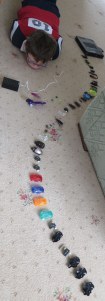 When he was younger, he’d line up rows of straws and twiddle them in turn between his hands; now he loves nothing more than to have his toys taken apart (or dismantle them himself) and see what’s inside. Sometimes he even puts them back together.
When he was younger, he’d line up rows of straws and twiddle them in turn between his hands; now he loves nothing more than to have his toys taken apart (or dismantle them himself) and see what’s inside. Sometimes he even puts them back together.
 Over the years, my son Tom, who has autism and is now eight, has gone through different phases with his toys, like any child. He’s always been fond of things that light up and he likes squidgy sensory toys and mechanical toys – things with wind-up mechanisms or motors and axles and cogs. I never would have thought that he’d learn to comment on whether toy cars are pull-back or friction-powered – but he does.
Over the years, my son Tom, who has autism and is now eight, has gone through different phases with his toys, like any child. He’s always been fond of things that light up and he likes squidgy sensory toys and mechanical toys – things with wind-up mechanisms or motors and axles and cogs. I never would have thought that he’d learn to comment on whether toy cars are pull-back or friction-powered – but he does.
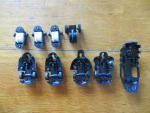 Some things he was once terrified of now fascinate him, such as fans and bubble machines. He also likes to arrange his toys or their constituent parts – maybe it’s a fond maternal eye, but I do love to see these arrangements. It seems to me that sometimes there’s an artistic (or scientific? Or both?) sensitivity and precision to them. Sometimes, though, it all turns into a crazy tangle! I thought I’d put together some of the pictures I’ve taken of his games down the years.
Some things he was once terrified of now fascinate him, such as fans and bubble machines. He also likes to arrange his toys or their constituent parts – maybe it’s a fond maternal eye, but I do love to see these arrangements. It seems to me that sometimes there’s an artistic (or scientific? Or both?) sensitivity and precision to them. Sometimes, though, it all turns into a crazy tangle! I thought I’d put together some of the pictures I’ve taken of his games down the years.
Sometimes he pimps his toys, like these creations – wheels and axles from one kind of toy, bodies from something else.
Here he is with another creation – a spinner.
Lining things up is good, especially with the help of a suitable wall.

The line below is of robot vacuum cleaners. Or he was pretending they were, anyway.
Not sure what these sensory animal toys make of the morass of other stuff they’re warily eyeing up.
Sometimes, it all just gets a bit chaotic…
But sometimes, the effect is rather magical.
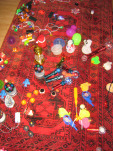
Soft toys do have their place, too. Well, Blue Bear, Tom’s autism awareness bear, definitely does.

The very favourite toy of all is the ipad. When it got broken once, it was necessary to make do with this subsitute while it was mended…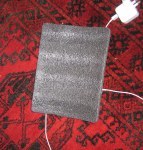
Insides of things are sometimes just as important and interesting as outsides.
Sometimes it is essential for alien eggs to live on the kitchen table for a while…
Other times, the best thing is being outside
checking out nature
or going somewhere new
like maybe the seaside
and exploring it with people you love.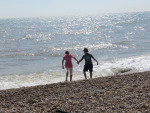


June 14, 2015
The impossible choice: Kramer vs Kramer
Has everybody seen Kramer vs Kramer? I watched it again about a year ago, as part of my research for my (nearly-finished) work-in-progress, which is partly about the aftermath of a custody battle. I was talking about it with a friend in a cafe a week ago when something unusual happened: the guy at the next table chipped in to tell us how that film had changed his life.
I’d just been talking about how I’d gone back to the book on which the film was based, and the case it makes for how, under some circumstances, the father should get primary custody after a split. Our neighbour at the next table was American, about my age – a 1970s child. He told us his parents had split up around the time Kramer vs Kramer came out and he had been about the same age as the boy in the film.
The original plan had been for him to live with his mother when everything was settled, but he had been living with his dad for a few months when his mum came to him and asked him who he wanted to live with: her, or his dad? And he chose his dad.
She’d asked him because she had seen the film and had been so affected by it. ‘A boy needs his father,’ she said.
So how had all this worked out? All right, it seemed – though it had meant the boy had to get on a plane to see his mother, which happened around three times a year.
Looking back from an adult’s perspective, he wondered if he’d understood the question in the way that she had meant it, as a choice between his parents. Perhaps he had really thought she was asking, ‘Do you want to stay here with Dad in the place you’ve got to know, or come with me to a place you’ve never seen?’ and, as children do, had plumped for what seemed most familiar, the least upheaval, at the time.
Stories are powerful things and sometimes they change lives…



